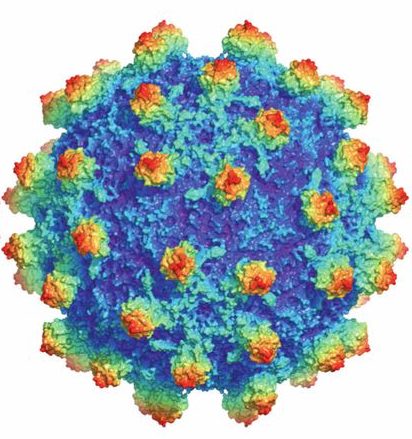by David S. Schultz
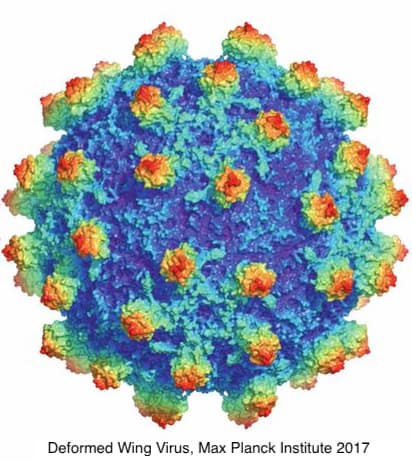 I have been asked for many years about the re-use of hive products from colony dead-outs into our new spring colonies. During the past couple of years, I have read hive product re-use Best Management Practices (BMP) that discuss deep freezing any frames from dead-outs for a period of at least 48 hours prior to re-use in other colonies. Of course, this advice applies assuming that there is no suspicion of American Foulbrood (AFB) in the dead-out hives, in the case of which the state apiary inspector should be contacted and the equipment should be burned.
I have been asked for many years about the re-use of hive products from colony dead-outs into our new spring colonies. During the past couple of years, I have read hive product re-use Best Management Practices (BMP) that discuss deep freezing any frames from dead-outs for a period of at least 48 hours prior to re-use in other colonies. Of course, this advice applies assuming that there is no suspicion of American Foulbrood (AFB) in the dead-out hives, in the case of which the state apiary inspector should be contacted and the equipment should be burned.
Recently, a 2020 paper from the Institute of Bee Health, University of Bern, Switzerland, titled “Honey Bee Virus Transmission via Hive Products” and written by Dominik Schittny and colleagues (http://www.mdpi.com/2306-7381/7/3/96), was introduced to me by one of my Master Beekeeper Candidate colleagues, Lisa Marie Ghezzi. This paper has some interesting, if not concerning, information regarding the use of hive products from one hive to another. In order to get my head around the results of this study, I conducted a limited literature review. I started this project with the intension of seeing if I could find other similar studies and helping me to develop a new set of BMP for my colonies and those of my mentees. During my review of various studies, I found some interesting related topics regarding honey bee genetics and immune responses to induced stresses. Since my journey during this review was enlightening and is worth sharing, I will be discussing the papers that I reviewed in chronological order, adding my comments and questions, and concluding with a list of BMP that I believe will minimize stresses and negative consequences for our colonies. I would like to credit Lisa Marie Ghezzi and my wife Jennifer Bess for their help in reviewing, editing, and contributing to this work.
PROCESS
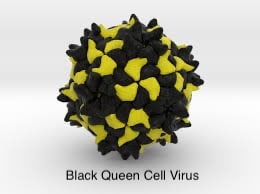 I did not do an exhaustive search; however, I spent several weeks looking for information about viral transmission and focused my search on the Deformed Wing Virus (DWV). DWV is ubiquitous in honey bees, is vectored by the Varroa mite, and is found even in one of the only reported Varroa free locations, Australia. DWV is also at the center of the July 2020 paper on virus transmission referenced above. I enlisted the help of Tom Jacobs, DVM to review the “Honey 2 Bee Virus Transmission via Hive Products” study to give me feedback on the quality of the study and the conclusions. Dr. Jacobs feels that overall the study was performed in accordance with the industry standards and that the conclusions were reasonable based on the study results.
I did not do an exhaustive search; however, I spent several weeks looking for information about viral transmission and focused my search on the Deformed Wing Virus (DWV). DWV is ubiquitous in honey bees, is vectored by the Varroa mite, and is found even in one of the only reported Varroa free locations, Australia. DWV is also at the center of the July 2020 paper on virus transmission referenced above. I enlisted the help of Tom Jacobs, DVM to review the “Honey 2 Bee Virus Transmission via Hive Products” study to give me feedback on the quality of the study and the conclusions. Dr. Jacobs feels that overall the study was performed in accordance with the industry standards and that the conclusions were reasonable based on the study results.
REVIEWED PAPERS
University of Illinois at Urbana-Champaign, (2014) “Scientists Track Gene Activity when Honey Bees Do and Don’t Eat Honey” (http://phys.org/news/2014-07-scientists-track-gene-honey-bees.html#:~:text=Scientists track gene activity when honey bees do,dietary changes in foraging honey bees, researchers found).
The practice of feeding our honey bee colonies sucrose and high-fructose corn syrup (HFCS) has come under recent review. Some scientists believe that poor nutrition plays a major role in the current high (over 40%) annual colony loss nationwide. Scientists are taking a closer look at the “changes in gene activity in response to diet in the western honey bee.” The study, focusing on the higher metabolic rate foraging bees, compared the gene activity when feeding the bees honey, HFCS, or sucrose. The results showed hundreds of gene activity differences in the honey-fed hives, including in those infected with DWV. Some of the genes that were activated affected protein metabolism, brain-signaling, and immune defense. Another referenced study showed that bees feeding on honey increased the activity of genes responsible for breaking down toxic substances such as pesticides. More work is needed to decode all the activated genes and discover the extent to which these changes affect bee health.
Swiss Bee Research Center, Bern Switzerland, (2015) “Overwintering is Associated with Reduced Expression of Immune Genes and Higher Susceptibility to Virus Infection in Honey Bees,” written by Nadja Steinmann and colleagues (http://journals.plos.org/plosone/article?id=10.1371/journal.pone.0129956).
In this paper the reported high winter colony losses, in the Northern Hemisphere, suggest the possibility of compromised immune function and higher susceptibility to disease for winter bees. This study documents the expression of eight immune genes during the natural occurring infection levels of DWV for both summer and winter bees. The test data shows that there is a correlation between high DWV loads in winter bees and the reduced expression of cellular immune response genes, the absence of which possibly increases the honey bee’s susceptibility to DWV. Winter bees are thought to have evolved to reduce “the energetically expensive immune system” possibly to save energy and increase winter survival. This survival mechanism may be giving DWV a greater foothold on our winter bees and result in increased winter losses. The study performed on colonies in Switzerland reports that “The newly emerged winter bees had an average DWV load more than 300-fold higher than the summer bees of the same age.” The study also discusses that high levels of DWV may be responsible for an immune-suppression effect on the honey bee.
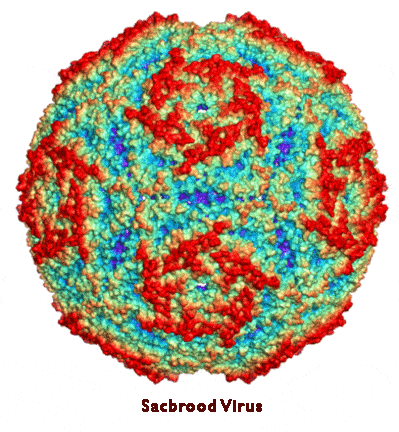 Two studies cited by the authors show that DWV has been detected in newly emerged honey bees not infested with Varroa, suggesting that DWV may be transmitted through vertical transmission. Strong fall colonies, those with strong nutritional reserves, are more likely to overwinter successfully than weaker colonies. It is likely that the detrimental effects of Varroa’s promotion of DWV occur during the entire life of the colony; however, its effect becomes critical in the late summer to fall/winter when the level of Varroa is peaking, and therefore DWV increase and the honey bees’ seasonal decline in immune function coincide.
Two studies cited by the authors show that DWV has been detected in newly emerged honey bees not infested with Varroa, suggesting that DWV may be transmitted through vertical transmission. Strong fall colonies, those with strong nutritional reserves, are more likely to overwinter successfully than weaker colonies. It is likely that the detrimental effects of Varroa’s promotion of DWV occur during the entire life of the colony; however, its effect becomes critical in the late summer to fall/winter when the level of Varroa is peaking, and therefore DWV increase and the honey bees’ seasonal decline in immune function coincide.
University of Kentucky, (2016) “The Buzz about Honey Bee Viruses,” written by Laura M. Brutscher and colleagues (http://journals.plos.org/plospathogens/article?id=10.1371/journal.ppat.1005757).
Honey bee viruses are transmitted both horizontally, hive to hive, and vertically, from a queen bee to her offspring. Colony virus transmission is “enhanced by crowded conditions and the routine transfer of nectar, pollen, and bee bread through trophallaxis.” Viruses that are detected in pollen and honey have been found in uninfected queen bees and have then been detected in eggs and progeny. The ectoparasitic mite Varroa plays a major roll in vectoring viruses such as DWV to honey bees. Honey bee viruses may also be spread to other honey bees during visits to floral resources. This form of horizontal transmission is disconcerting and is one of the most difficult forms for the beekeeper to defend against.
RNA interference (RNAi) is an important insect antiviral defense. The introduction of RNAi in the lab has resulted in the reduction of infected bees and larvae. Additional experiments are on-going with the hope that the results will produce a more robust understanding of the function of RNAi and its possible use for reducing viral load. Penn State University, (2020) “Viruses in Honey Bees” (http://extension.psu.edu/viruses-in-honey-bees).
Honey bee colonies are subject to many viruses, however, if the colony is strong and healthy, most “infections are not problematic.” There are currently over 20 viruses affecting our honey bee colonies, with DWV leading the way. Varroa have been shown to transmit DWV by inserting its mouthparts in the bee cuticle, resulting in a direct connection between the signs of DWV and the presence of damaging levels of Varroa. The two paralysis viruses, Israeli Acute Paralysis Virus (IAPV) and Acute Bee Paralysis Virus (ABPV), are also serious problems believed to be vectored by Varroa, and they have been found to be serious health stressors to honey bee colonies. The possible routes of transmission of the viruses may include various forms of contact with other honey bees. Within a colony, these include contact between “drone to queen during mating, queen to egg, nurses to larvae during feeding, and worker to worker during trophallaxis.” More broadly, transmission can also occur when our bees are feeding on contaminated food such as honey stores in their own colony. It is believed that mite transmission of the DWV may select for more virulent strains of the virus. Moreover, due to a reduction in wound healing at the Varroa feeding site, young mites gaining better nutrition grow in number. “Treatment with chemical miticides to control Varroa such as Amitraz”, may “cause bees to be less tolerant to virus infection.” Conversely, providing our colonies with plentiful high-quality diets with pollen from multiple sources can help bees lower colony viral levels. Diagnosing and treating for viral infections is a difficult task. The testing methods to identify viruses are not currently available to the general public, and there are no specific approved treatments for viral infections in honey bees. There are, however, methods to possibly minimize the exposure and damage by viral infections to our honey bee colonies, and these will be discussed in the following (BMP) section.
Iowa State University and the University of Illinois, (April 2020) “Researchers Find Bee Virus Spreads by Altering Honey Bees’ Social Distancing Behavior”, written by Adam Dolezal and colleagues (http://www.cals.iastate.edu/news/releases/researchers-find-bee-virus-spreads-altering-honey-bees-social-distancing-behavior#:~:text=Researchers Find Bee Virus Spreads by Altering Honey,ways that boost the virus’ ability to spread).
Dr. Gene Robinson from the Carl R. Woese Institute for Genomic Biology, University of Illinois at Urbana-Champaign, is one of the contributors to this study focusing on the Israeli Acute Paralysis Virus (IAPV). Dr. Robinson was a keynote speaker at the Maryland State Beekeepers Association November 2019 meeting, and during the Q&A following one of his talks, he discussed an additional study with data showing the ability for honey bees to transmit some viruses to one another through trophallaxis.
This April 2020 study found that the IAPV virus can alter the behavior and physiology in honey bees in ways that boosts the ability for the virus to spread. One of the ways that viruses evolve quickly is through the high-density placement of our colonies, especially the thousands of pollinator colonies allowing for quick horizontal transfer and possible mutation of the deadly viruses. The study also indicated that bees infected by IAPV were more likely to be accepted into foreign colonies by allowing them to circumvent the guards of uninfected colonies. During the study, it was noted that the infected bees engaged in more trophallaxis with the uninfected guard bees, indicating that something in the IAPV infected bees was different, possibly their pheromones. The study also indicated that the IAPV infected forager bees tended to become lost more often than healthy bees further contributing to horizontal transmission. One of the researchers explained that this apparent ability for the virus to alter the behavior of the infected bees may be connected to some of the “human-created environments in modern agriculture.”
Institute of Bee Health, University of Bern, Switzerland, (2020) “Honey Bee Virus Transmission via Hive Products,” written by Dominik Schittny and colleagues (http://www.mdpi.com/2306-7381/7/3/96)
This is the study that inspired me to take on this review. Specifically, this Swiss study was performed to determine whether commercial hive products could transfer viruses to fed colonies. Apparently in Europe it is not uncommon for beekeepers to feed their colonies commercial hive products such as honey and pollen purchased from stores. In order to determine whether there were concerns with pathogen transmission of these products, the researchers 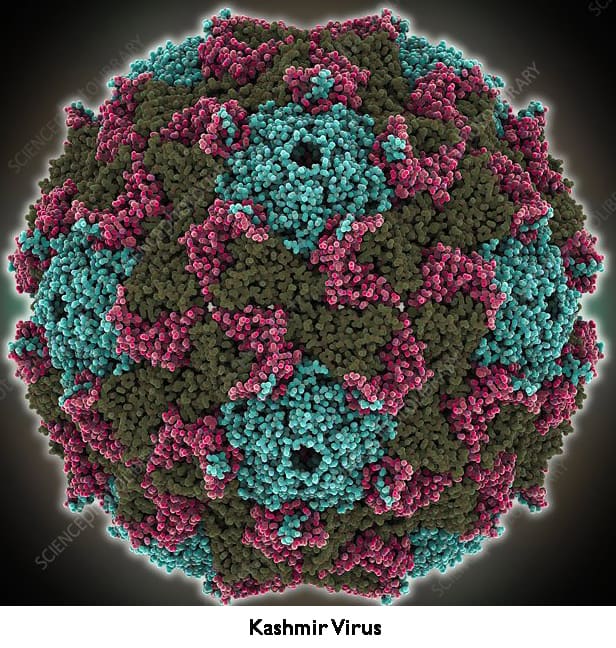 engaged in a study with “fully crossed hoarded cage experiments” in order to estimate the transmission risk of sharing these commercial products with honey bee colonies. They specifically used the pathogen DWV-A for their experiments. They provided the caged western honey bees with samples of contaminated wax, pollen and honey in three different concentrations (low, medium and high) while also maintaining a background level concentration control group. For contaminated honey and pollen, a positive association with mortality and the DWV-A was observed with the high concentrations always resulting in infections, the medium concentrations resulting in infections about 50% of the time, and the low concentrations resulting in infections about 20% of the time. Citing work that concluded that colonies given frames of honey and pollen from infected hives became infected, this study focused on wax, pollen, and honey and did not consider royal jelly or propolis due to their antimicrobial properties. The study used local honey bees that were tested several months apart prior to commencing the study and showed the lowest level of DWV-A, about half of the low concentration level to be fed to the bees in the study. Newly emerged bees were fed the different concentration levels of DWV-A contaminated honey and pollen and were exposed to the contaminated comb.
engaged in a study with “fully crossed hoarded cage experiments” in order to estimate the transmission risk of sharing these commercial products with honey bee colonies. They specifically used the pathogen DWV-A for their experiments. They provided the caged western honey bees with samples of contaminated wax, pollen and honey in three different concentrations (low, medium and high) while also maintaining a background level concentration control group. For contaminated honey and pollen, a positive association with mortality and the DWV-A was observed with the high concentrations always resulting in infections, the medium concentrations resulting in infections about 50% of the time, and the low concentrations resulting in infections about 20% of the time. Citing work that concluded that colonies given frames of honey and pollen from infected hives became infected, this study focused on wax, pollen, and honey and did not consider royal jelly or propolis due to their antimicrobial properties. The study used local honey bees that were tested several months apart prior to commencing the study and showed the lowest level of DWV-A, about half of the low concentration level to be fed to the bees in the study. Newly emerged bees were fed the different concentration levels of DWV-A contaminated honey and pollen and were exposed to the contaminated comb.
A limit of this study is that none of the tested bees were reared in the contaminated comb. The contaminated comb was simply placed into the test cages with the bees. The control groups were fed un-contaminated honey and pollen and exposed to un-contaminated comb. The food and comb for the control group were tested and “irradiated with UV light for 120 minutes” to ensure that the samples were free of the virus. During the spiking of the wax, it was discovered that the virus “would degrade at the temperature” that the wax melted, so that the researchers had to apply the virus solution to the surface of the wax. The test cages for the bees in this study consisted of clear polystyrene cups turned upside-down so the lid was the bottom of the cage. Death rates of the control group were less than 15% during the ten-day experiments. The contaminated honey caused greater death than the control with the high concentration causing the highest mortality followed by the medium concentration. The same results were observed in the contaminated pollen with the correlation of highest mortality occurring in the high and medium concentrations of the pollen. No significant differences in mortality were noted in the different contamination levels of the wax.
After the dead bees were tested for DWV-A, the bees from the higher contamination group were found to have “significantly more virus (one to five orders of magnitude) than the initial fed amount” indicating that the high concentration DWV-A group got infected, and the virus was replicating within the bees. In the medium DWV-A concentration group, only two in five were infected with the honey and pollen, and three in ten were infected with wax. In the low DWV-A group, only one in ten were infected with the honey and two in ten infected by the wax, with none being infected by the pollen.
The results indicate that DWV-A transmission via hive products is feasible and that mortality increases when the bees are fed higher contaminated levels of honey and pollen. The different concentrations in the wax did not show differences in mortality over the control possibly because the wax did not serve as a food source. The concentration of the DWV-A in the dead bees from the low concentration level group showed less DWV-A copies than were fed indicating a lower rate of infection in this group.
The study cites a 2010 paper that showed “that viruses contained in frames of honey and bee bread remain infective even after being stored for 6-months at room temperature.” Still, “it is known that viral particles exposed to environmental conditions” such as humidity and heat may quickly deteriorate. The study found that honey was the most efficient transmitter of the DWV-A; however, the researchers opine that in non-laboratory conditions, the transmission of the virus in low concentrations is only about 2% and is considered low risk for low contamination levels in pollen. The odds of transmission of the virus through wax foundation is considered minimal since the wax is melted during processing probably killing the virus. By contrast the practice of transferring wax comb from one hive to another should be considered a possible vehicle of transmission.
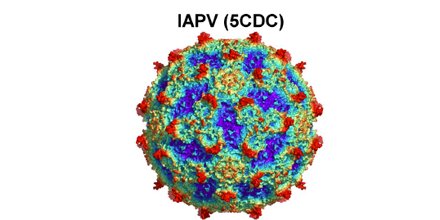 SUMMARY
SUMMARY
Through my review of these studies, several themes are repeated:
- Strong healthy colonies exhibit Social Immunity and are less likely to succumb to death by viruses,
- Abundant and diverse nutritional resources reduce the negative stresses caused by Varroa and viruses,
- Summer bees appear to have a more robust immune defense system,
- Winter bees can have higher DWV loads,
- Viruses can be spread vertically and horizontally,
- Viral contaminated hive products appear to be able to transmit viruses to honey bees,
- Low levels of virus infection appear to result in low risk of transmission,
- The deleterious effects of DWV becomes greater in late summer when Varroa levels are peaking,
- Dedicated control of Varroa is our best tool to reduce the deadly effects of viruses in our honey bee colonies.
By necessity, the researchers must set up sterile environments for their testing. The world of the honey bee as a part of the superorganism includes birth, life, work, fulfillment, death, and, yes, stress. A thorough application of this information to the lives of bees in our colonies is yet to be discovered, but if our goal as beekeepers is to minimize the stresses that our colonies must work into their survival equation, then I think a serious appraisal of these types of studies is worthy. Based on this short and very limited review, I have prepared a list of BMP, many of which I have been taught and have been teaching for years. I will note when I think that I am being over-cautious with some of them, but I also appreciate that we all have our own beekeeping philosophies, and if this list generates questions and discussion, then all the better. In beekeeping there are many times different answers for the same question, but perhaps Winnie the Pooh said it best: “You never can tell with bees.”
Best Management Practices:
CONTROL VARROA MITES:
- Develop a specific Varroa Management Plan (VMP) for your apiary(s) (visit Honey Bee Health Coalition’s website),
- Perform Varroa Mite testing frequently starting in spring and increase frequency in late summer through fall treating when Varroa levels are above the recommended action level,
- When purchasing new packages and nucleus colonies, inquire what Varroa treatments were completed by the seller, if any,
- Pre-purchase your VMP Varroa treatments to ensure availability,
- Use the following BMP to help reduce Varroa exposure.
Reduce Horizontal Transmission:
- Limit the number of colonies per apiary,
- Consider increasing the distance between colonies,
- Orient colonies to reduce drift,
- Use anti-robbing screens,
- Avoid sharing frames from sick colonies to healthy ones,
- Avoid combining sick colonies with healthy ones,
- Avoid using previously used equipment in your colonies,
- Sanitize when moving from one hive to another.
Cultural:
- Keep resistant bees (VSH, Russian, Survivors, etc.),
- Provide a diverse high-quality diet (see http://beescape.org/),
- Reduce pesticide exposure.
Mechanical:
- Remove old combs (consider removing comb after 2 years instead of 3),
- Encourage colonies to build new comb in the spring through mid-summer,
- Encourage propolis deposition in the hive bodies.
Reduce disease transmission:
- Identify Varroa infested colonies, DWV or Paralysis viruses in the colony during inspections and treat for Varroa and quarantine affected colonies (may be over cautious to quarantine),
- Avoid using diseased hive resources in other colonies,
- Test ½ cup of the dead bees from a dead-out for Varroa and if the numbers are high: to minimize risk consider doing the following: o Not using the hive resources in other colonies (may be over cautious not to use the resources),
- Clean empty comb may be ok to re-use,
- Deep freezing any frames for a minimum of 48 hours prior to re-use,
- Exposing clean comb to UV light* following freezing and prior to re-use,
- Contact your local bee inspector for an inspection of your equipment and advice on causes for dead-outs.
New Colony Set Up:
- For new packages, test for Varroa during the installation and treat for Varroa for packages with Varroa levels above the recommended action level. Take care when installing new packages on comb from other hives. Clean empty comb from a honey super may be the lowest risk for use (see the reduce disease transmission section above). Consider placing only two clean combs during the package installation, and feed 1:1 syrup to encourage comb building on the remaining foundation frames. Avoid feeding honey stores from dead-outs or mite infested colonies.
- For new nucleus colonies, verify that Varroa has been managed from the seller prior to pick up, and then test for Varroa upon installation of the nucleus colony into your equipment. Treat for Varroa in colonies above the recommended action level. If high levels of Varroa are detected contact the seller.
Healthy colonies exhibit Social Immunity and appear able to navigate the four P’s (pests, pathogens, pesticides, and poor nutrition). Our responsibility when husbanding our bees is to remove or minimize as many stressors as possible from our bees in the pursuit of supporting strong healthy colonies. There are many stressors that we cannot control, so our energies should be focused on those that we can impact. You may not be able to adhere to all the above BMP, but the more BMP that you can adopt, the less stress your colonies will endure. You will help them thrive, and your bees will thank you in their special ways.
*A quick review of the availability of UV type C equipment (which is the best form of UV light for disabling viruses) indicates that there are very few if any safe and reliable versions of UV type C equipment available for the average consumer. It does appear that heat in the form of sunlight may be a better/safer alternative. Studies show that temperatures near 130F will disable viruses. That temperature for an extended period may also soften beeswax (with a melting temperature of 144F), but I think exposing the comb to several hours of sunlight will not hurt and may reduce the viable viruses that may be attached to the comb.
Bottom line is that we do not have a good solution yet, but if we are careful and make good choices, I think that we can minimize the impact of the viruses on our colonies.

